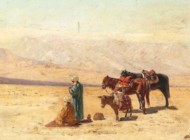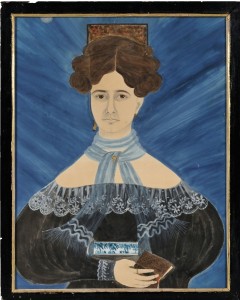
The top selling lot of the two-day sale was this portrait of Electa Snow Pierce, painted by Ruth and Dr Samuel Shute in 1832. It was a well-known painting, last selling in the Susan and Ray Egan sale in 2006. This time, it brought $339,000, about $100,000 more than it did in the Egan sale.
Review and Onsite Photos by Rick Russack, Catalog Photos Courtesy Skinner, Inc.
MARLBOROUGH, MASS. — The lesson from Skinner’s August 14–15 sale was that if the material is exceptional, estimates are irrelevant. Such was the case with the first lot sold, which was a miniature paint-decorated six-drawer chest. Estimated at $2,500, it quickly sold for $30,700. The box was followed a few minutes later by a pair of superb Windsor chairs fetching $55,350, more than four times the estimate, to be the top selling lot of day one.
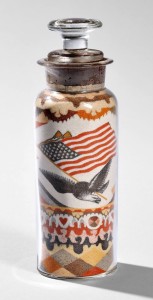
Bringing the second highest price of the sale was a sand art bottle with a spreadwinged eagle, an American flag and colorful borders. Done by Andrew Clemens, circa 1890, it realized $81,180.
Selling on day two was the top lot of the sale, a portrait by Ruth and Dr Samuel Shute. It brought more than double estimate, finishing at $339,000, which may be an auction record for a portrait of a woman by the artist couple. Throughout the sale, there were examples of the differing values for items of differing quality; the rules of good, better and best were apparent. For example, there were two other Shute works in the sale that brought far less. Several works by Rufus Porter sold at widely differing prices, as did works by Joseph Davis. Comments by respected authorities demonstrate this thought.
Skinner had put together a varied sale, with multiple examples of many Americana categories. There were several lots of late Seventeenth–early Eighteenth Century furniture, along with needlework, groups of chalkware, painted tin, painted furniture, many paintings, sealed bottles, weathervanes, trade signs, wallpaper covered boxes, Lehnware, stoneware and mocha. As is often the case these days, the crowd in the salesroom was small; fewer than 50 on day one and about a dozen on day two. The material, however, had been accessible in three days of previews during Antiques Week, so there were numerous absentee bids and very active phone and internet bidding. The sale grossed $2.3 million with 368 successful bidders.
The top lot of the sale, a portrait of Electa Snow Pierce, was painted by Ruth Shute (1803–1882) and Dr Samuel Shute, (1803–1836) and was so inscribed on the reverse, along with the date, February 20, 1832. It also had a note on the back identifying the sitter. The watercolor and pencil work showed the sitter half length, with a blue scarf and black dress, with a tortoiseshell comb in her hair, against a bright royal blue background. Its selling price, $339,000, exceeded the price it attained in the Susan and Raymond Egan sale in 2006 by nearly $100,000. It was bought by Jack O’Brien, on behalf of a client. O’Brien told Antiques and The Arts Weekly that his client liked several things in the auction but elected to concentrate on acquiring one outstanding piece. “My client wanted an iconic Shute and this was it. The blue background made the portrait really stand out. I think part of the reason for the price jump since the Egan sale was the Shute that sold in the 2014 Esmerian sale for $665,000. That sort of recalibrated the market for the best Shutes.”
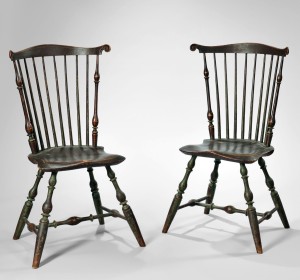
Perhaps one of the finest pair of fanback Windsor side chairs to be offered recently, the chairs were probably made in Massachusetts, circa 1795. Steve Fletcher, Bill Samaha and Arthur Liverant used superlatives when talking about the chairs, which earned $55,350. When asked what made them great, Liverant simply responded, “Everything.”
In addition to the “iconic” Shute portrait, there were two other Shutes in the sale, both unsigned. A watercolor and pencil half-length portrait of a woman in a black dress with elaborate lacework, with a comb in her hair and holding a book, sold within the estimates at $26,400. Another, this one a pastel half-length portrait of a woman in a black dress, holding a book, went for $12,300.
The two-day sale started with several pieces of late Seventeenth–early Eighteenth Century furniture, much from one collection. The provenance of the collection could only be traced back to the 1930s, when it was assembled. From that collection, and setting the tone for the entire sale, was the first item to be sold — an early Eighteenth Century miniature paint-decorated six-board box. It was painted blue, with dark blue and red squiggles, with pintle hinges and rosehead nails. Estimated at $2,500, it sold for $30,700 to Woodbury, Conn., dealer David Schorsch, who later said that he had owned it before. “I bought that box when I was about 15 years old. It was at a White Plains show and George Schoellkopf had it, priced at $1,900. I don’t remember how a 15-year-old kid could have bought something for that price, but it was a great little box.” Four phone lines competed with a bidder in the room and an internet bidder.
Another example, reinforcing the thought that estimates might be irrelevant when truly exceptional things are being sold, took place a few minutes later when a pair of painted fanback Windsor side chairs, probably made in Massachusetts, circa 1795, sold for $55,350, more than four times their high estimate. There was no debating the quality of these chairs. When Skinner executive vice president Steve Fletcher offered the lot, he said, “This is nicest pair I’ve ever found on a house call.” Bill Samaha, when asked, added, “These are as good as they get. Windsors were soft for awhile but the interest is back. Surface, form, provenance, condition — they had it all.” When Arthur Liverant was asked, “What made these chairs great?,” he had a simple, concise answer: “Everything.” The chairs had concave crest rails, eight spindles, carved saddle seats, boldly turned legs and the original surface of green paint.
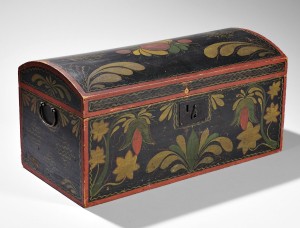
Another of the sale’s surprises was this paint-decorated, dome-top trunk, circa 1827, with boldly colored and stylized red, yellow and green flowers within borders of wavy lines. Both top and front were decorated and it sold for $24,600.
The collection of early furniture included four joint and turned stools, the best of which sold for $18,450, more than 12 times estimate. Others sold within estimates. An Eighteenth Century cross-base light stand, with a complex vase and ring-turned support, with traces of red, earned $9,225. A late Seventeenth Century painted pine chest over two drawers, with original cast brass teardrop pulls, brown graining, black moldings and a red case, went for $18,450, while a three-window wood lantern with a single sheet iron candle socket, fetched $3,198. One of the few pieces selling below its estimate was a late Seventeenth Century oak joined table with one drawer, which went out at $20,910.
Continuing with early material, a group of blown sealed bottles sold well over estimates, most to Jim Hagenbuch of Glass Works Auctions. He said these were for his own collection, not for resale. The one he liked best, which cost him $7,995, was a bulbous-form bottle with a string rim and a seal that was marked “H/Littledale, 1762.” A mallet-form bottle with an applied string rim and a seal, dated 1785, reached $584 and an onion-form wine bottle, with a seal dated 1737, realized $4,305. Hagenbuch said that nearly all sealed bottles were made in England, and the earliest date known so far is 1660. He also said that it is possible some sealed bottles were made in America, perhaps at Wistarburg, a south New Jersey glass house, which began operations in 1739, but this has not been confirmed.
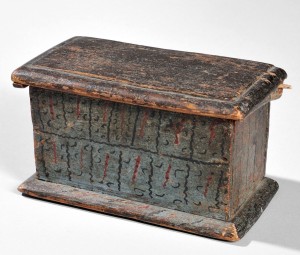
Suggesting the way sale might go, this miniature paint-decorated six-board box sold for more than 12 times its estimate, realizing $30,750. It was bought by David Schorsch who had first bought it when he was 15 years old, paying $1,900 at that time. It was painted blue, with dark blue and red squiggle line decoration and was dated to the early Eighteenth Century.
Like the Shutes, results for paintings by Jacob Maentel, William Matthew Prior, Joseph Davis and Rufus Porter also demonstrated significant variations. A Joseph Davis (1811–1865) watercolor portrait of a young family, seated facing one another with a grain painted table between them and ingrain carpet on the floor, reached $23,370, while a single portrait of young man, also on ingrain carpet, brought $5,228, and another watercolor of a seated gentleman with a child fetched only $3,321. Buyers were also selective with works by Maentel (1763–1863). A watercolor of a boy with his hat, holding a parrot and framed by trees, went to a phone bidder for $6,675, while a full-length portrait of a gentleman, also with a hat and also with trees and hills in the background, made $4,613.
Prices for Rufus Porter (1792–1884) miniature watercolors ranged from a bust-length portrait of a young girl in a red dress, $1,722, to a bust-length portrait of a gentleman with sideburns, $4,613. An oil on canvas by William Matthew Prior (1806–1873), depicting a young boy in a red dress with his wagon, earned $20,910, while a portrait of a bearded young man by the same artist went out for only $861.
The second day included several Pennsylvania items, including painted tinware, chalkware, Lehnware and wallpaper covered boxes. Many of the pieces had been in important collections, including Machmer, Olde Hope Antiques, Richard Flanders Smith and Clyde and Betty Youtz. Prices for painted tinware were strong, with a red bread basket from the Esther Ludwig collection bringing $22,808 and a brightly painted cann, with a starburst pattern, which went out at $6,150.
Wallpaper boxes ranged from $246 for a small round box to $2,952 for a brightly colored lozenge-shaped box from the Richard Flanders Smith collection. The top chalkware lot was a scarce whippet, which earned $1,045; other pieces sold between $369 for a squirrel and $1,476 for a large cat. Lehnware prices ranged from $461 for a small egg cup to $1,476 for a pair of saffron cups.
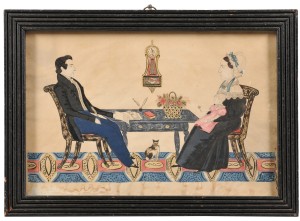
One of a group of Joseph Davis watercolors, this one reached the highest price, $23,370. Two others sold for much less.
Numerous exceptional items did well. A polychrome paint-decorated, compass-and-fan carved wall box finished at $14,760, more than 13 times the estimate. A yellow paint-decorated, one-drawer stand from Norway, Maine, realized $15,990, while another example having turned legs and a splashback went for $13,530. A particularly nice paint-decorated dome top trunk, probably from Rhode Island, circa 1827, earned $24,600. It had stylized red, yellow and green flowers on the top and front, framed in red banding with panels of wavy lines. Its price, too, was nearly five times the estimate. Certainly surprising most people was a red painted hat rack with a turned tapering shaft, 12 knobtop spindles for hats, on a tripod base. It went way over the estimates, bringing $11,993.
Also certainly in the “big surprise” category was a circa 1890 sand art bottle with an American flag and spread-winged eagle by deaf mute artist Andrew Clemens. It wound up being the second highest priced item in the sale, fetching $81,180. And, yes, it was another of those exceptional items that far exceeded its estimate. Clemens produced hundreds of bottles in his lifetime, originally selling them for $5 to $7 each.
After the sale, David Schorsch commented on the results. “I think this sale indicates a general uptick in the market for good early furniture and good folk art. Some of the prices this time were above prerecession levels. I’m thinking particularly of the Shute portrait. To me, this is not the ‘irrational exuberance’ as the market was termed a few years ago. This is well thought out exuberance, with collectors and dealers going after the very best that they can. The Lew Scranton sale a couple of months ago also reflected that thinking, as did the material sold at the recent New Hampshire shows. I know that dealers are more optimistic and are bidding more widely than they did in the recent past.”
All prices reported include the buyer’s premium.
For additional information, www.skinnerinc.com or 508-970-3200.
[slideshow_deploy id=’1000275956′]


